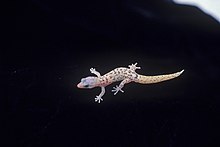
Sphaerodactylus is a genus of geckos from the Americas that are distinguished from other Gekkota by their small size, by their round, rather than vertical, eye pupils, and by each digit terminating in a single, round adhesive pad or scale, from which their name is derived. All species in this genus are rather small, but two species, S. ariasae and S. parthenopion, are tiny, and – with a snout-vent length of about 1.6 cm (0.63 in) – the smallest reptiles in the world.

The golden coquí is a rare species of frog endemic to Puerto Rico.

The Mona ground iguana is a rock iguana that is endemic to Mona Island, Puerto Rico, and is the largest native terrestrial lizard in Puerto Rico. It was previously considered a subspecies of the rhinoceros iguana.

Desecheo is a small uninhabited island of the archipelago of Puerto Rico located in the northeast of the Mona Passage; 13 mi (21 km) from Rincón on the west coast of the main island of Puerto Rico and 31 mi (50 km) northeast of Mona Island. It has a land area of 0.589 sq mi. Politically, the island is administered by the U.S. Department of the Interior, U.S. Fish and Wildlife Service as the Desecheo National Wildlife Refuge, but part of Barrio Sabanetas of Mayaguez.

The yellow-shouldered blackbird, known in Puerto Rican Spanish as mariquita de Puerto Rico or capitán, is a species of blackbird endemic to Puerto Rico. It has black plumage with a prominent yellow patch on the wing. Adult males and females are of similar appearance. The species is predominantly insectivorous.

Anolis roosevelti, also known commonly as the Virgin Islands giant anole, Roosevelt's giant anole or the Culebra giant anole, is an extremely rare or possibly extinct species of lizard of the genus Anolis in the family Dactyloidae. The species is native to the Virgin Islands and Vieques.

The fauna of Puerto Rico is similar to other island archipelago faunas, with high endemism, and low, skewed taxonomic diversity. Bats are the only extant native terrestrial mammals in Puerto Rico. All other terrestrial mammals in the area were introduced by humans, and include species such as cats, goats, sheep, the small Indian mongoose, and escaped monkeys. Marine mammals include dolphins, manatees, and whales. Of the 349 bird species, about 120 breed in the archipelago, and 47.5% are accidental or rare.
The Desecheo National Wildlife Refuge is a National Wildlife Refuge in Puerto Rico. It is part of the Caribbean Islands National Wildlife Refuge Complex.

Sphaerodactylus klauberi is a species of gecko, a lizard in the family Sphaerodactylidae The species is endemic to the archipelago of Puerto Rico.

The fauna of the United States Virgin Islands consists of 144 species of birds, 22 species of mammals, 302 species of fish and 7 species of amphibians. The wildlife of the U.S.V.I. includes numerous endemic species of tropical birds, fish, and land reptiles as well as sea mammals. The only endemic land mammals are six species of native bats: the greater bulldog bat, Antillean fruit-eating bat, red fruit bat, Brazilian free-tailed bat, velvety free-tailed bat and the Jamaican fruit bat. Some of the nonnative land mammals roaming the islands are the white-tailed deer, small Asian mongoose, goats, feral donkeys, rats, mice, sheep, hogs, dogs and cats.
Sphaerodactylus beattyi, also known commonly as the Saint Croix's sphaero, Beatty's least gecko, and the cotton ginner gecko, is a species of lizard in the family Sphaerodactylidae. The species is endemic to Saint Croix in the United States Virgin Islands. There are two recognized subspecies.
Sphaerodactylus levinsi, also known commonly as the Desecheo gecko or the Isla Desecheo least gecko, is a species of lizard in the family Sphaerodactylidae. The species is endemic to Desecheo Island in Puerto Rico.
The Mona least gecko is a species of lizard in the family Sphaerodactylidae. It is endemic to Isla de Mona of Puerto Rico.
Sphaerodactylus nicholsi, also known commonly as Nichols least gecko, Nichol's dwarf sphaero or the Puerto Rican crescent sphaero, is a species of lizard in the family Sphaerodactylidae. The species is endemic to Puerto Rico.

Sphaerodactylus roosevelti, also known commonly as Roosevelt's beige sphaero or Roosevelt's least gecko, is a small species of lizard in the family Sphaerodactylidae. The species is endemic to Puerto Rico.
Sphaerodactylus townsendi, known commonly as the Townsend's dwarf sphaero or Townsend's least gecko, is a small species of lizard in the family Sphaerodactylidae. The species is endemic to Puerto Rico.

Mona and Monito Islands Nature Reserve consists of two islands, Mona and Monito, in the Mona Passage off western Puerto Rico in the Caribbean. Mona and Monito Islands Nature Reserve encompasses both land and marine area, and with an area of 38,893 acres it is the largest protected natural area in the Commonwealth of Puerto Rico. Much like the Galapagos Islands in the Pacific Ocean, the Mona and Monito Islands reserve represents a living laboratory for archaeological, biological, geological, oceanographical and wildlife management research.












